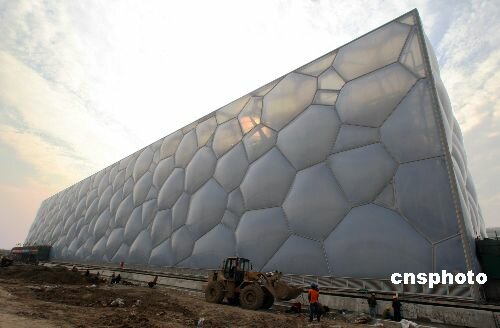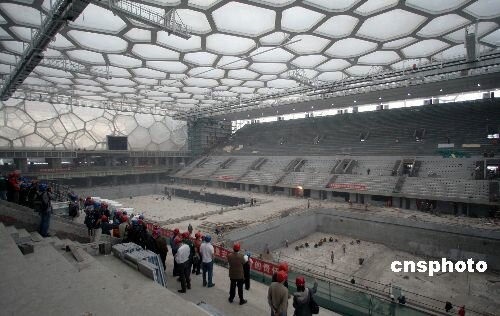The National Aquatics Center in Beijing.


“…The Water Cube was initially designed by PTW Architects (an Australia Architectural company) [2], CSCEC International Design and Arup with structural Engineers Arup conceiving the structure. The structure was built by CSCEC (China State Construction Engineering Corporation). Comprising a steel space frame, it is the largest ETFE clad structure in the world with over 100,000 m² of ETFE pillows that are only eight one-thousandths of an inch in total thickness,[3] The ETFE cladding allows more light and heat penetration than traditional glass, resulting in a 30% decrease in energy costs[3].
The outer wall is based on the Weaire-Phelan structure, a foam (structure formed by soap bubbles).[4] The pattern is formed by taking a slice through the foam, and it was chosen in preference to the Kelvin foam because the more complex Weaire-Phelan structure results in more irregular, organic patterns than slices through the regular Kelvin foam.[5]
The structure will have a capacity of 17,000[3]during the games that will be reduced to 6,000 afterwards. It also has a total land surface of 65,000 square metres and will cover a total of 7.8 acres (32,000 m²)[3]…”
[EDIT: appears to be a hoax: http://www.snopes.com/risque/tattled/shuttle.asp Hat tip to zarex.]
Pierre Kohler, author of The Final Mission: Mir, The Human Adventure says:
The issue of sex in space is a serious one,” he says. “The experiments carried out so far relate to missions planned for married couples on the future International Space Station, the successor to Mir. Scientists need to know how far sexual relations are possible without gravity.”
He cites a confidential Nasa report on a space shuttle mission in 1996. A project codenamed STS-XX was to explore sexual positions possible in a weightless atmosphere.
Twenty positions were tested by computer simulation to obtain the best 10, he says. “Two guinea pigs then tested them in real zero-gravity conditions. The results were videotaped but are considered so sensitive that even Nasa was only given a censored version.”
Only four positions were found possible without “mechanical assistance”. The other six needed a special elastic belt and inflatable tunnel, like an open-ended sleeping bag.
Mr Kohler says: “One of the principal findings was that the classic so-called missionary position, which is so easy on earth when gravity pushes one downwards, is simply not possible.”
Gah! So what are the positions? And where can I get one of those “inflatable tunnels”?
http://www.jpaerospace.com/
The atmosphere as a ladder to space.
Balloons have carried people and machines to the edge of space for over seventy years. JP Aerospace is developing the technology to fly a balloonor more accurately, their relative, the airshipdirectly to orbit.
Flying an airship directly from the ground to orbit is not practical. An airship large enough to reach orbit would not survive the winds near the surface of the Earth. Conversely, an airship that could fly from the ground to upper atmosphere would not be light enough to reach space. The resulting configuration is a three-part architecture for using lighter-than-air vehicles to reach space.
The first part is an atmospheric airship. It will travel from the surface of the Earth to 140,000 feet. The vehicle is operated by a crew of three and can be configured for cargo or passengers. This airship is a hybrid vehicle using a combination of buoyancy and aerodynamic lift to fly. It is driven by propellers designed to operate in near vacuum.
The second part of the architecture is a suborbital space station. This is a permanent, crewed facility parked at 140,000 feet. These facilities, called Dark Sky Stations (DSS), act as the way stations to space. The DSS is the destination of the atmospheric airship and the departure port for the orbital airship. Initially, the DSS will be the construction facility for the large orbital vehicle.
The third part of the architecture is an airship/dynamic vehicle that flies directly to orbit. In order to utilize the few molecules of gas at extreme altitudes, this craft is big. The initial test vehicle is 6,000 feet (over a mile) long. The airship uses buoyancy to climb to 200,000 feet. From there it uses electric propulsion to slowly accelerate. As it accelerate it dynamically climbs. Over several days it reaches orbital velocity.
Low cost bulk access to space
Scaleable Technology.
True reusability, multiple orbital flights before servicing.
Large structures can be placed already assembled in orbit.
Brings safety and reliability to reaching space.
Both the climb to orbit and reentry are slow controlled processes. No high reentry heating, no big fuel tanks to explode.
Opens up the solar system.
Once in orbit, the airship is a spacecraft. With its solar/electric propulsion, it can now proceed to any destination in the solar system.

